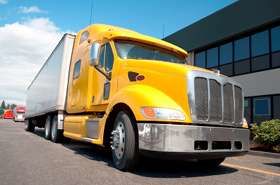Swift Orientation/Mentor Phase
Topic 11922 | Page 1
 conrats!!!
conrats!!!
I will let our resident Swift experts answer the questions
First day is a drug test, some paperwork, some videos and slide shows. Second and third days are the same except the drug test. The whole thing could be done in a day if it were organized. The last day you get a driver number and meet your mentor. When you drive is up to him or her.
And, CONGRATULATIONS! !!!!

First day is a drug test, some paperwork, some videos and slide shows. Second and third days are the same except the drug test. The whole thing could be done in a day if it were organized. The last day you get a driver number and meet your mentor. When you drive is up to him or her.
And, CONGRATULATIONS! !!!!
Thank you both for the congrats. When I tell you it was not easy, I mean that. I am proud of myself and excited for my future. But if orientation could be done in one day, why isn't it? Because I was informed that they pay you for two out of the three days of orientation, so it seems to me it would be in their best interest to make it a one day ordeal. Furthermore, if you're sitting somewhere watching a bunch of videos instead of driving, you're not making them any money. I don't know, it just seems like it's not in their best interest to spread some videos and paperwork over the course of three days when they can do it all in one. And how many videos do you need to watch? One on safety and one bragging about their greatness and benefits seems like enough, you know?
I guess in the end, it doesn't matter too much because I have what many others that I know don't right now--a job!

Little trucker congratulations on passing. First 3days are spent on company policy insurance and deductions if I remember correctly and some required training such as hazmat , and I can't remember what else. Errol might be able to help you out more than me on that. I can't speak for how other trainers do it.
But I never let a student drive first thing if we have a full days run I will drive for a few hours. Let them see how the truck works and what all my little knobs and switches do. I will talk to them and explain how the truck handles differently when loaded. What I expect from them and what the rules are for my truck. Find out if they have any concerns or questions , buy them a meal and then let them drive. I don't tell them when I am going to let them drive.
They get to nervous thinking about it. Then I sit in the left seat for the next 50 hours correcting them when they do thing wrong and explaining how to do it better . and letting them know when they do a good job. Then if I am comfortable with them let them run solo but make sure they understand they can get me up at anytime for anything. I am always up if we're going to a shipper or receiver. Stopping for brakes or fuel. If the weather is something they are not used to or if were in the mountains.
As they progress I let them make more and more decisions. In the last 30 to 50 hours there the one running the truck from were to stop and trip planing. To telling me when they will drive and I will drive and for how long. Then they graduate. Remember this is a lot to take in all at once so don't, take it one bite at a time. Being nervous totally normal. I would be worried if you were not nervous . take a deep breath and enjoy the ride. Its one he'll of a trip.
Congrats
HAZMAT:
Hazardous Materials
Explosive, flammable, poisonous or otherwise potentially dangerous cargo. Large amounts of especially hazardous cargo are required to be placarded under HAZMAT regulations
Shipper:
The customer who is shipping the freight. This is where the driver will pick up a load and then deliver it to the receiver or consignee.
My name was invoked, again! I'll let it go, this time.
Here's my Swift Orientation & Mentor Training link.
The first day is filling out forms, and, I think, another cup of pee. And that waiting.
The second and third days are real learning days. Swift policies and operations, basic hazmat (no, it doesn't help get you qualified.) Swift safety practices, etc. This all goes about a day and a half. The final part is you get to meet your mentor.
From there, it's get on the truck because you're OTR now. A bit of personal orientation from your mentor and then you start your 50 hours in-the-seat Drive time. Your mentor gets to sit in the passenger seat watching you and teaching you how to drive for that 50 hours. I think my mentor got bored. Pretty much at that 50th hour point, your truck switches to team operation and you're on your own while your mentor is in the sleeper berth. By then you shoulde able to handle the truck on the road. My mentor always got out at shippers and receivers and watch the backing. (You need to have at least 40 documented opportunities to back the truck to a dock.)
HAZMAT:
Hazardous Materials
Explosive, flammable, poisonous or otherwise potentially dangerous cargo. Large amounts of especially hazardous cargo are required to be placarded under HAZMAT regulations
Shipper:
The customer who is shipping the freight. This is where the driver will pick up a load and then deliver it to the receiver or consignee.
OTR:
Over The Road
OTR driving normally means you'll be hauling freight to various customers throughout your company's hauling region. It often entails being gone from home for two to three weeks at a time.
Sleeper Berth:
The portion of the tractor behind the seats which acts as the "living space" for the driver. It generally contains a bed (or bunk beds), cabinets, lights, temperature control knobs, and 12 volt plugs for power.

My name was invoked, again! I'll let it go, this time.
Here's my Swift Orientation & Mentor Training link.
The first day is filling out forms, and, I think, another cup of pee. And that waiting.
The second and third days are real learning days. Swift policies and operations, basic hazmat (no, it doesn't help get you qualified.) Swift safety practices, etc. This all goes about a day and a half. The final part is you get to meet your mentor.
From there, it's get on the truck because you're OTR now. A bit of personal orientation from your mentor and then you start your 50 hours in-the-seat Drive time. Your mentor gets to sit in the passenger seat watching you and teaching you how to drive for that 50 hours. I think my mentor got bored. Pretty much at that 50th hour point, your truck switches to team operation and you're on your own while your mentor is in the sleeper berth. By then you shoulde able to handle the truck on the road. My mentor always got out at shippers and receivers and watch the backing. (You need to have at least 40 documented opportunities to back the truck to a dock.)
Thanks for the info. I think people keep bringing you up because you're top notch at your job, you're very knowledgeable, and you, of course, drive for Swift which a lot of people go for or plan to go for. You seem to have a lot of insight and wisdom and I think I'm not the only one who can see that. So think of it as more of an honor if someone brings your name up. :)
HAZMAT:
Hazardous Materials
Explosive, flammable, poisonous or otherwise potentially dangerous cargo. Large amounts of especially hazardous cargo are required to be placarded under HAZMAT regulations
Shipper:
The customer who is shipping the freight. This is where the driver will pick up a load and then deliver it to the receiver or consignee.
OTR:
Over The Road
OTR driving normally means you'll be hauling freight to various customers throughout your company's hauling region. It often entails being gone from home for two to three weeks at a time.
Sleeper Berth:
The portion of the tractor behind the seats which acts as the "living space" for the driver. It generally contains a bed (or bunk beds), cabinets, lights, temperature control knobs, and 12 volt plugs for power.

your truck switches to team operation and you're on your own while your mentor is in the sleeper berth.
I don’t want to steal theLT’s mojo on his thread, but I have a question about that comment. I am still researching on how all of this training will play out so maybe I am missing something, but your comment did cause some concern. You mentioned about the mentor sleeping and I’ve been wondering how some of this OTR would play out during my training.
I have never been able to sleep in anything that is moving; ever, and I’ve been like this since I was a little kid. I have made several long haul flights into Asia where I went without sleep for roughly 40 hours (24 hours in the air and 16 hours on the ground). I also made quite a few long hauls into the Middle East which were 35 hours (19 air, 16 ground). I didn’t get one second of sleep until I arrived at my destination. Same thing coming back into the US, in fact I would not get a rental car until after I slept because I knew I was too tired to drive.
So ………. if I will be expected to be part of a team and ‘sleep’ while someone else is driving, I know right now I will not get any sleep. And if I am too tired to drive safely, I would not drive. I’m afraid now that could become a huge issue for me and I’m hoping someone can clarify how you sleep during training. This may burst my bubble.
OTR:
Over The Road
OTR driving normally means you'll be hauling freight to various customers throughout your company's hauling region. It often entails being gone from home for two to three weeks at a time.
Sleeper Berth:
The portion of the tractor behind the seats which acts as the "living space" for the driver. It generally contains a bed (or bunk beds), cabinets, lights, temperature control knobs, and 12 volt plugs for power.
your truck switches to team operation and you're on your own while your mentor is in the sleeper berth.
I don’t want to steal theLT’s mojo on his thread, but I have a question about that comment. I am still researching on how all of this training will play out so maybe I am missing something, but your comment did cause some concern. You mentioned about the mentor sleeping and I’ve been wondering how some of this OTR would play out during my training.
I have never been able to sleep in anything that is moving; ever, and I’ve been like this since I was a little kid. I have made several long haul flights into Asia where I went without sleep for roughly 40 hours (24 hours in the air and 16 hours on the ground). I also made quite a few long hauls into the Middle East which were 35 hours (19 air, 16 ground). I didn’t get one second of sleep until I arrived at my destination. Same thing coming back into the US, in fact I would not get a rental car until after I slept because I knew I was too tired to drive.
So ………. if I will be expected to be part of a team and ‘sleep’ while someone else is driving, I know right now I will not get any sleep. And if I am too tired to drive safely, I would not drive. I’m afraid now that could become a huge issue for me and I’m hoping someone can clarify how you sleep during training. This may burst my bubble.
Not speaking for anyone else - but once the training progresses to where the truck is running as a "team operation" - you will get your 10 hour break, while your partner is driving. And the truck will likely be moving while this is going on.
From what I've gathered here - every "training company" (Swift, Prime, etc.) runs the second phase of OTR training like this, so this is something that's likely going to be unavoidable.
So sorry if this "bursts your bubble" - but this is something you're going to have to adjust to.
Rick
OTR:
Over The Road
OTR driving normally means you'll be hauling freight to various customers throughout your company's hauling region. It often entails being gone from home for two to three weeks at a time.
Sleeper Berth:
The portion of the tractor behind the seats which acts as the "living space" for the driver. It generally contains a bed (or bunk beds), cabinets, lights, temperature control knobs, and 12 volt plugs for power.

Dan B., hoping it ain't so...
So ………. if I will be expected to be part of a team and ‘sleep’ while someone else is driving, I know right now I will not get any sleep. And if I am too tired to drive safely, I would not drive. I’m afraid now that could become a huge issue for me and I’m hoping someone can clarify how you sleep during training. This may burst my bubble.
Sorry to say, teaming is exactly that, one driver sleeps while the other one drives. No getting around this with most of the carriers. I have seen some smaller companies that execute training solo, but I do not recall names (maybe someone else can shed light on this). Sleeping on a moving truck is (at least for me) difficult but I was able to do it using ear-plus and two pillows.
New Reply:
New! Check out our help videos for a better understanding of our forum features

















Preview:
This topic has the following tags:
Swift Transport Becoming A Truck Driver Hours Of Service On The Road In Training Truck Driver Training Truck Driving Orientation







 TT On Facebook
TT On Facebook
Today, I passed my CDL licensing test. It was 3 hours long and boy was it nerve-wracking! Tomorrow, I turn my paperwork into the DMV and get my license. I have a few days of rest and then Monday I start a 3 day orientation. What do you have to do at a job orientation that takes 3 days? Also, they say once orientation is up you will instantly be getting on a truck with a trainer. What should I expect? Is it normal to be nervous? Do you drive your first day? What happens?
CDL:
Commercial Driver's License (CDL)
A CDL is required to drive any of the following vehicles:
Dm:
Dispatcher, Fleet Manager, Driver Manager
The primary person a driver communicates with at his/her company. A dispatcher can play many roles, depending on the company's structure. Dispatchers may assign freight, file requests for home time, relay messages between the driver and management, inform customer service of any delays, change appointment times, and report information to the load planners.DMV:
Department of Motor Vehicles, Bureau of Motor Vehicles
The state agency that handles everything related to your driver's licences, including testing, issuance, transfers, and revocation.